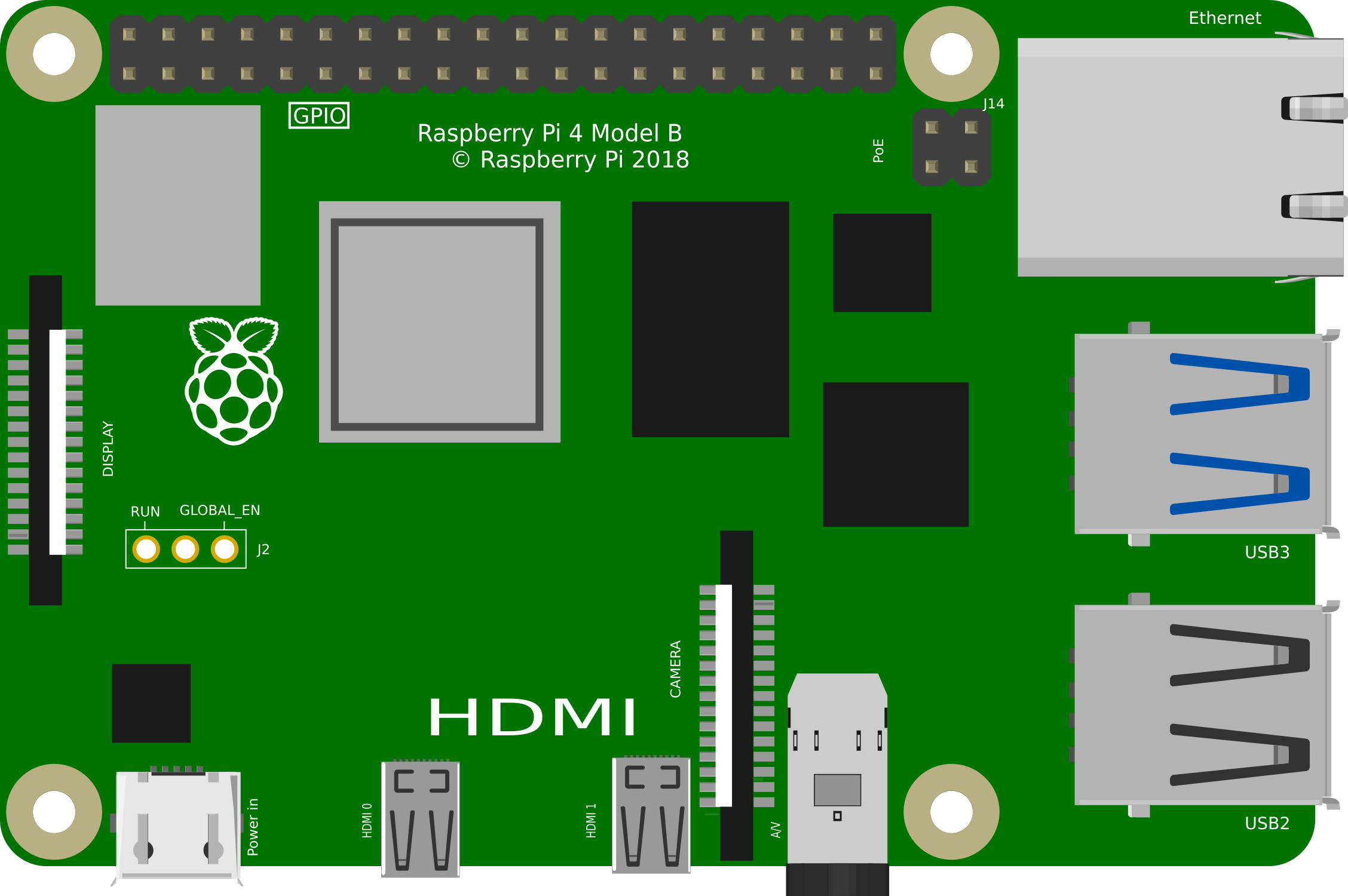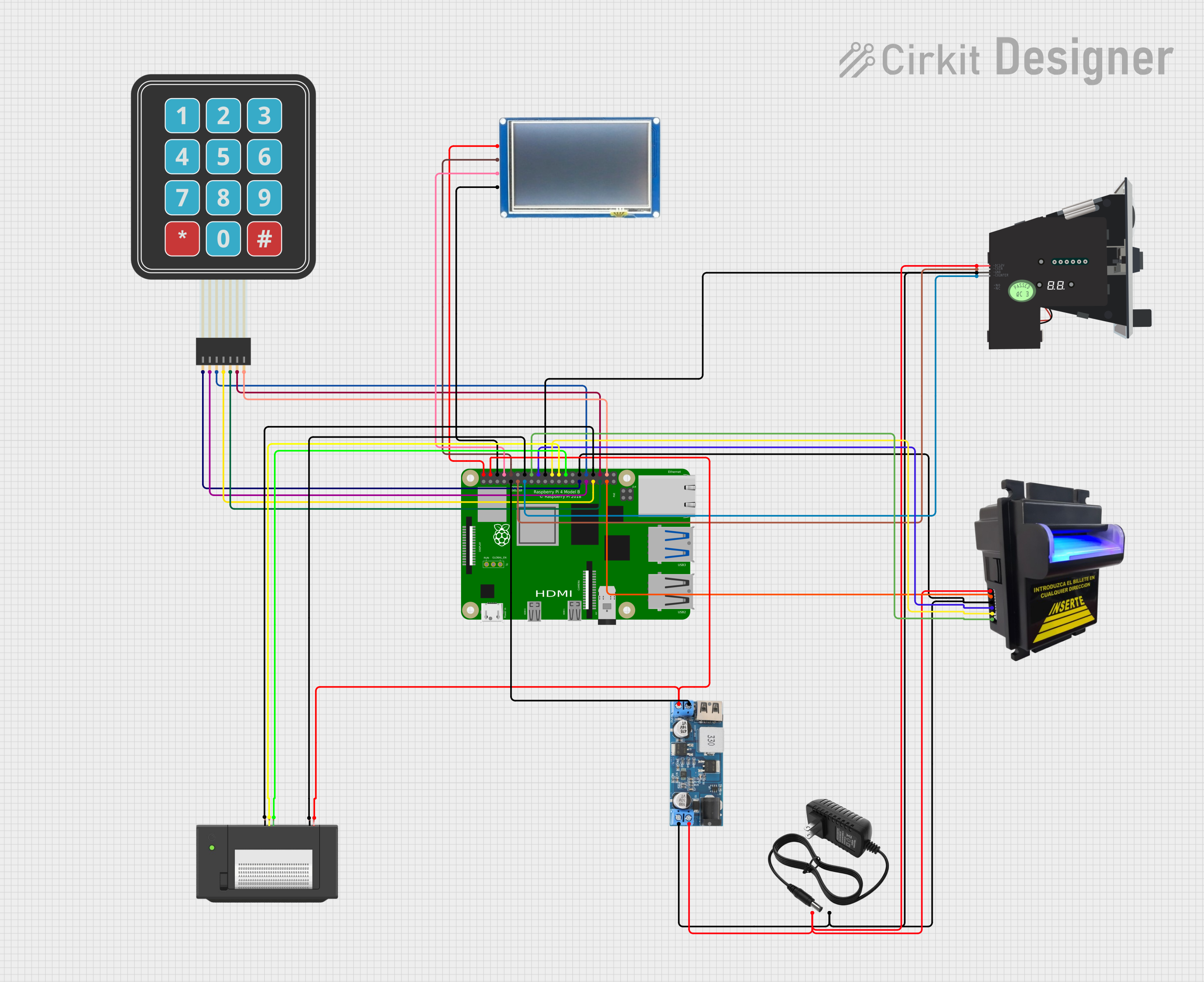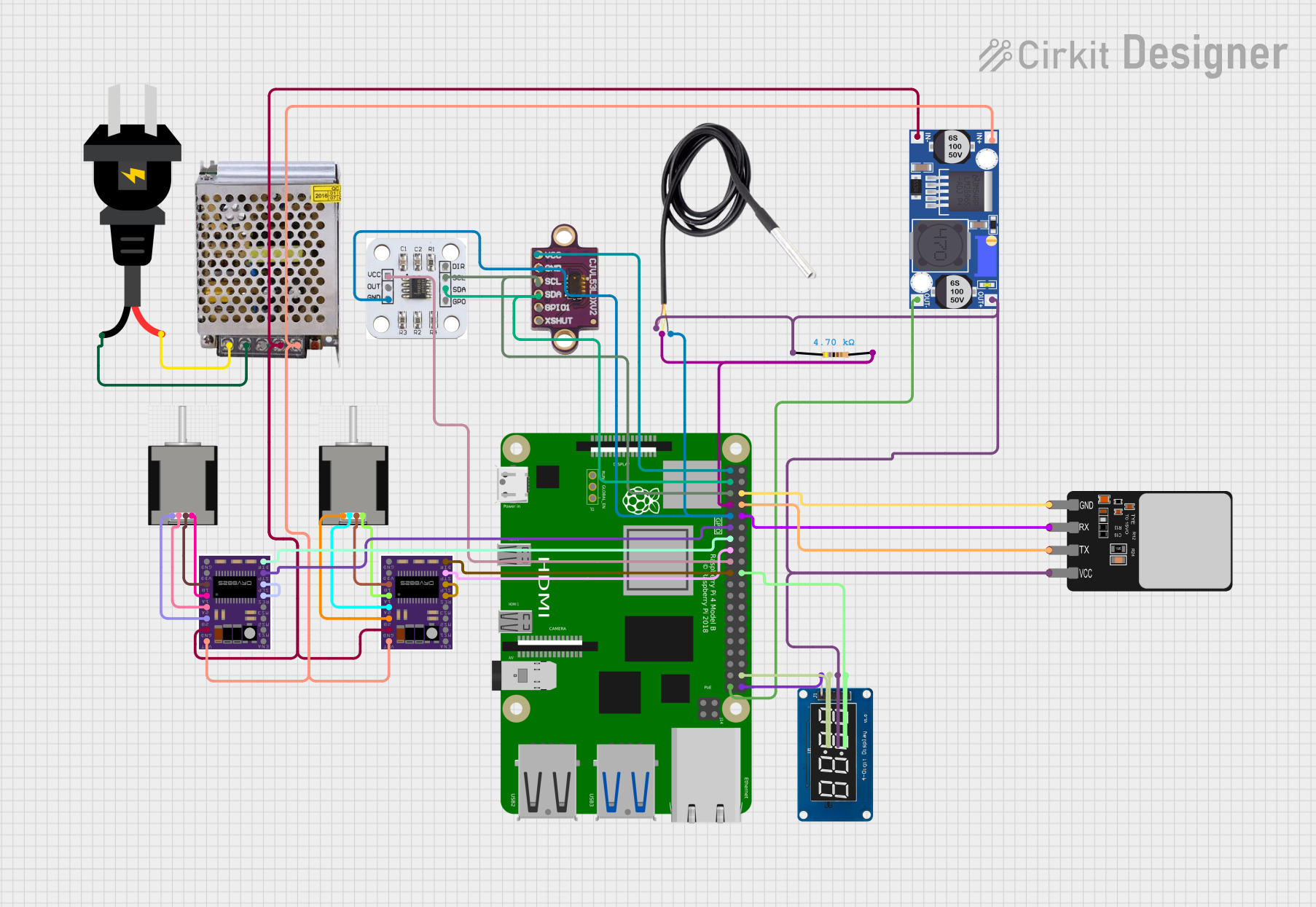
How to Use Raspberry Pi 4 Model B: Examples, Pinouts, and Specs

 Design with Raspberry Pi 4 Model B in Cirkit Designer
Design with Raspberry Pi 4 Model B in Cirkit DesignerIntroduction
The Raspberry Pi 4 Model B is a compact, affordable single-board computer designed for a wide range of applications. It features a powerful quad-core processor, up to 8GB of RAM, multiple USB ports, dual micro-HDMI outputs, and Ethernet connectivity. This versatile device is ideal for projects such as programming, media centers, IoT applications, robotics, and more. Its small form factor and robust performance make it a popular choice for both hobbyists and professionals.
Common applications include:
- Building media centers (e.g., Kodi or Plex)
- IoT (Internet of Things) devices and smart home automation
- Educational programming and coding projects
- Robotics and hardware prototyping
- Lightweight web servers and networked applications
Explore Projects Built with Raspberry Pi 4 Model B

 Open Project in Cirkit Designer
Open Project in Cirkit Designer
 Open Project in Cirkit Designer
Open Project in Cirkit Designer
 Open Project in Cirkit Designer
Open Project in Cirkit Designer
 Open Project in Cirkit Designer
Open Project in Cirkit DesignerExplore Projects Built with Raspberry Pi 4 Model B

 Open Project in Cirkit Designer
Open Project in Cirkit Designer
 Open Project in Cirkit Designer
Open Project in Cirkit Designer
 Open Project in Cirkit Designer
Open Project in Cirkit Designer
 Open Project in Cirkit Designer
Open Project in Cirkit DesignerTechnical Specifications
Key Technical Details
| Specification | Details |
|---|---|
| Processor | Broadcom BCM2711, Quad-core Cortex-A72 (ARM v8) 64-bit SoC @ 1.5GHz |
| RAM Options | 2GB, 4GB, or 8GB LPDDR4-3200 SDRAM |
| USB Ports | 2x USB 3.0, 2x USB 2.0 |
| Video Output | 2x micro-HDMI ports, up to 4K resolution |
| Ethernet | Gigabit Ethernet |
| Wireless Connectivity | Dual-band 802.11ac Wi-Fi, Bluetooth 5.0 |
| GPIO Pins | 40-pin GPIO header |
| Storage | microSD card slot |
| Power Supply | 5V/3A via USB-C |
| Dimensions | 85.6mm x 56.5mm x 17mm |
Pin Configuration and Descriptions
The Raspberry Pi 4 Model B features a 40-pin GPIO (General Purpose Input/Output) header. Below is a table summarizing the pin configuration:
| Pin Number | Pin Name | Functionality |
|---|---|---|
| 1 | 3.3V Power | Power supply |
| 2 | 5V Power | Power supply |
| 3 | GPIO2 (SDA1) | I2C Data |
| 4 | 5V Power | Power supply |
| 5 | GPIO3 (SCL1) | I2C Clock |
| 6 | Ground | Ground |
| 7 | GPIO4 | General-purpose I/O |
| 8 | GPIO14 (TXD0) | UART Transmit |
| 9 | Ground | Ground |
| 10 | GPIO15 (RXD0) | UART Receive |
| ... | ... | ... |
| 39 | Ground | Ground |
| 40 | GPIO21 | General-purpose I/O |
For a complete GPIO pinout, refer to the official Raspberry Pi documentation.
Usage Instructions
How to Use the Raspberry Pi 4 Model B in a Circuit
- Powering the Raspberry Pi: Use a 5V/3A USB-C power supply to power the board. Ensure the power supply is reliable to avoid voltage drops.
- Connecting Peripherals: Attach a keyboard, mouse, and monitor via the USB and micro-HDMI ports. Alternatively, use SSH or VNC for headless operation.
- Booting the OS: Flash a microSD card with a compatible operating system (e.g., Raspberry Pi OS) using tools like Raspberry Pi Imager. Insert the microSD card into the slot and power on the device.
- Using GPIO Pins: Connect external components (e.g., LEDs, sensors) to the GPIO pins. Use a breadboard and jumper wires for prototyping.
Important Considerations and Best Practices
- Cooling: The Raspberry Pi 4 Model B can generate significant heat under load. Use a heatsink or fan for cooling, especially in enclosed cases.
- Power Supply: Ensure the power supply provides sufficient current (3A) to avoid instability.
- Static Protection: Handle the board carefully to avoid static discharge, which can damage components.
- GPIO Voltage Levels: GPIO pins operate at 3.3V logic levels. Avoid applying higher voltages to prevent damage.
Example: Blinking an LED with GPIO and Arduino UNO
The Raspberry Pi 4 Model B can control an LED using its GPIO pins. Below is an example Python script using the RPi.GPIO library:
Import the GPIO library and time module
import RPi.GPIO as GPIO import time
Set the GPIO mode to BCM (Broadcom pin numbering)
GPIO.setmode(GPIO.BCM)
Define the GPIO pin connected to the LED
LED_PIN = 18
Set the LED pin as an output
GPIO.setup(LED_PIN, GPIO.OUT)
Blink the LED in a loop
try: while True: GPIO.output(LED_PIN, GPIO.HIGH) # Turn on the LED time.sleep(1) # Wait for 1 second GPIO.output(LED_PIN, GPIO.LOW) # Turn off the LED time.sleep(1) # Wait for 1 second except KeyboardInterrupt: # Clean up GPIO settings on exit GPIO.cleanup()
**Steps to Run the Code**:
1. Connect an LED to GPIO18 (pin 12) with a 330-ohm resistor in series.
2. Save the script as `blink.py` on the Raspberry Pi.
3. Run the script using `python3 blink.py`.
Troubleshooting and FAQs
Common Issues and Solutions
The Raspberry Pi does not boot:
- Ensure the microSD card is properly inserted and contains a valid OS image.
- Verify the power supply provides sufficient current (5V/3A).
- Check for any visible damage to the board or components.
Overheating:
- Use a heatsink or fan to cool the board.
- Avoid running the Raspberry Pi in a poorly ventilated enclosure.
GPIO pins not working:
- Double-check the GPIO pin configuration and connections.
- Ensure the
RPi.GPIOlibrary is installed (pip install RPi.GPIO).
No display on the monitor:
- Verify the micro-HDMI cable is connected to the correct port.
- Check the monitor's input source and resolution compatibility.
FAQs
Can I power the Raspberry Pi 4 Model B via GPIO pins? Yes, you can power the board using the 5V and GND pins, but this bypasses the onboard power management and is not recommended.
What operating systems are compatible with the Raspberry Pi 4 Model B? The Raspberry Pi supports Raspberry Pi OS, Ubuntu, and other Linux-based distributions. Some lightweight versions of Windows (e.g., Windows IoT Core) are also supported.
Can I use the Raspberry Pi 4 Model B for gaming? Yes, it can run retro gaming emulators like RetroPie or Recalbox, but it is not suitable for modern PC gaming.